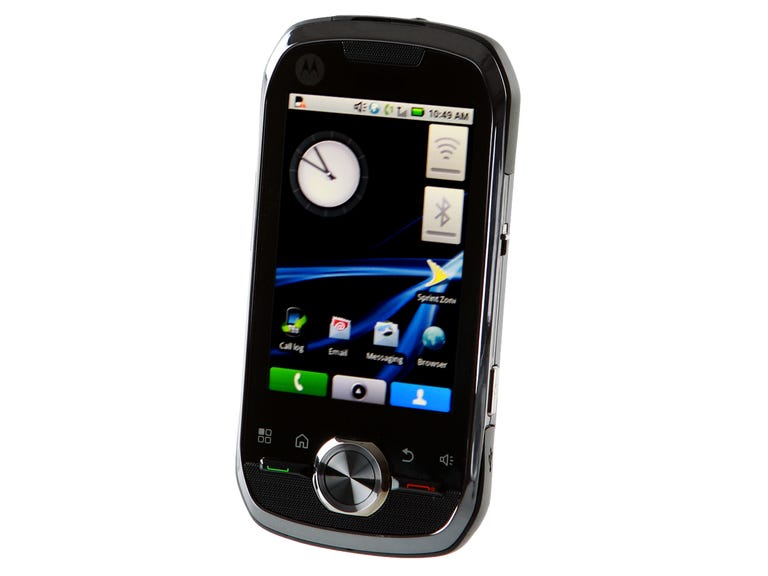 Why You Can Trust CNET
Why You Can Trust CNET Motorola i1 (Sprint Nextel) review: Motorola i1 (Sprint Nextel)
Motorola i1 (Sprint Nextel)
Though the Motorola i1 first debuted for Boost Mobile, we initially heard about it as a Sprint Nextel phone. As we mentioned in our review of the Boost Mobile version, the Motorola i1 is notable because it is the first-ever Google Android phone to run on Nextel's iDEN network. It is also one of the first Android smartphones to be certifiably "rugged," plus it supports Nextel's venerable push-to-talk network. It's by no means the best Android phone out there--it only comes with Android 1.5, and you won't get the fastest data speeds on iDEN--but Nextel addicts will be happy that they finally have an Android phone they can call their own. The Motorola i1 for Sprint Nextel is available for $149.99 after a two-year service agreement.
The Good
The Bad
The Bottom Line
Design
The Motorola i1 from is 4.65 inches long by 2.34 inches wide by 0.5 inch thick, and is clad in a military-certified casing that is built to withstand the elements: blowing rain, dust, shock, vibration, extreme temperatures, low pressure, salt fog, humidity, and solar radiation. However, it's not water-resistant, so we wouldn't take this on your next diving adventure.

Aside from the little things like the appearance of the clock and the Bluetooth and Wi-Fi widgets, the Motorola i1 from Sprint Nextel is physically identical to the Boost Mobile version. Because of that, we won't bore you with too many details, and direct you on over to the Motorola i1 for Boost Mobile review for more on the touch-screen and overall controls of the Motorola i1.
Features
Unfortunately, like with the Boost Mobile version, the Motorola i1 from Sprint Nextel comes with Android 1.5. This is a rather obsolete version of Android, as there are already phones on the market with OS 2.2, and most phones these days come with at least Android OS 2.1. Even the most basic Android phones are equipped with OS 1.6. Motorola claims this is because the company wanted the first iDEN Android phone to be absolutely stable and solid, which is a fine explanation, but here's hoping that Motorola rolls out an OS update to the i1 soon.

Aside from the usual PIM and Google functions, the Motorola i1 from Sprint Nextel is equipped with a few Sprint-specific features like Nascar Sprint Cup Mobile, Sprint Zone, and Sprint Football Live. And, of course, the i1 uses Nextel Direct Connect for its push-to-talk service. The i1 also comes with Wi-Fi, Opera Mobile, the Amazon MP3 Store, GPS, Bluetooth, and a 5-megapixel camera with LED flash. Again, check out the Boost Mobile version of the phone for the full rundown of the phone's features.
Performance
We tested the Motorola i1 in San Francisco using Sprint Nextel. Happily, the sound quality over Sprint Nextel is the same as over Boost Mobile. This shouldn't be a surprise, as both use the same airwaves (Boost Mobile is owned by Sprint). Callers' voices came through with excellent quality all around, with little to no static and great volume and clarity.
Similarly, callers enjoyed good call quality on their end. Voice quality was maybe a bit harsher than that of a landline call, but it was not a deal breaker by any means. Speakerphone calls went very well, too; volume was nice and loud, though we did suffer some tinny and echo effects on our end. The same goes for audio playback over the phone's speakers, so we would recommend the use of a headset when possible.
The network speeds on the Motorola i1 were satisfactory for the most part. Loading the CNET home page took around 15 seconds; the BBC Web site loaded in about 32 seconds on Opera Mini. YouTube clips took quite a while to buffer--about 10 seconds per video--and video quality was very pixelated.
The i1 has a 600MHz ARM11 Freescale processor, which worked well enough for us. The proximity sensor kicked in quickly, as did the accelerometer. Applications closed and opened quickly, though the phone bogged down a little bit as we multitasked among apps. The camera activated in just a second or two after pressing the camera key.
The Motorola i1 has a 1,400mAH lithium ion battery with a rated battery life of 3.5 hours talk time and 4.17 days standby time. In our battery drain tests, we had a tested talk time of 2 hours and 58 minutes. According to FCC radiation tests, the i1 has a digital SAR of 0.81 watt per kilogram.


